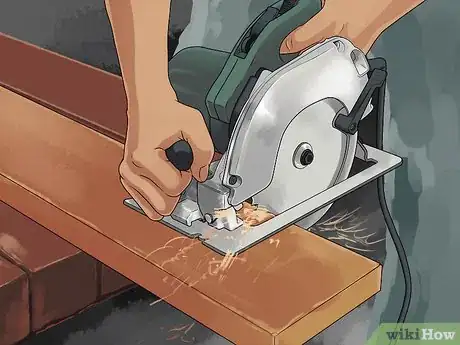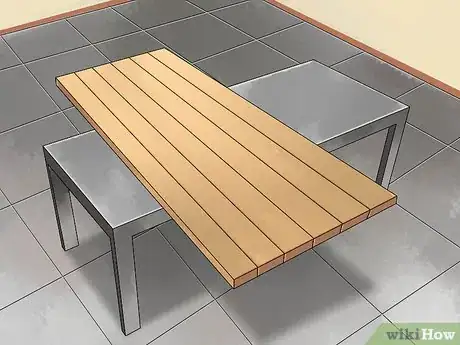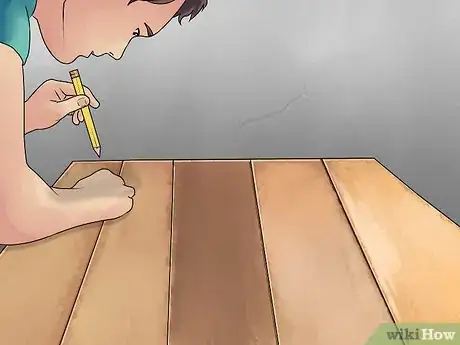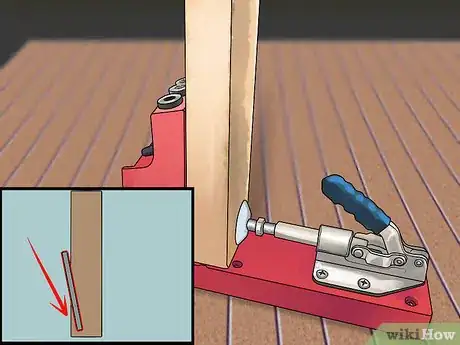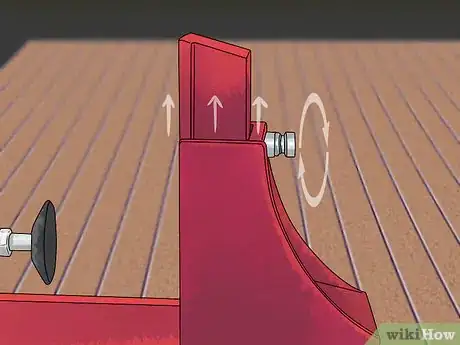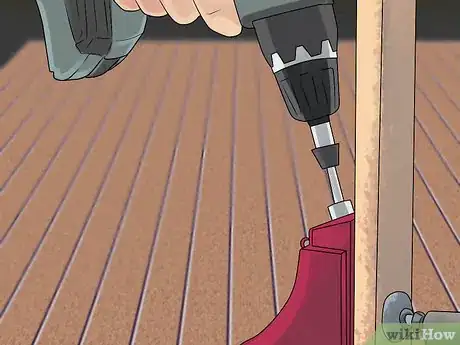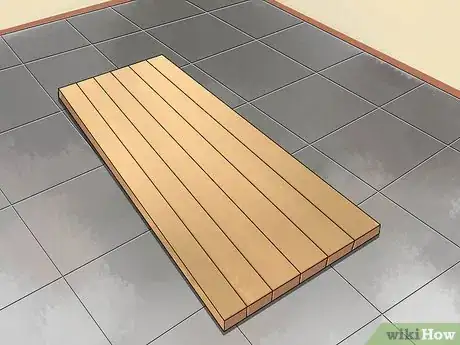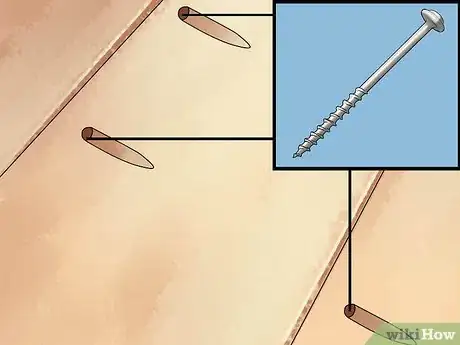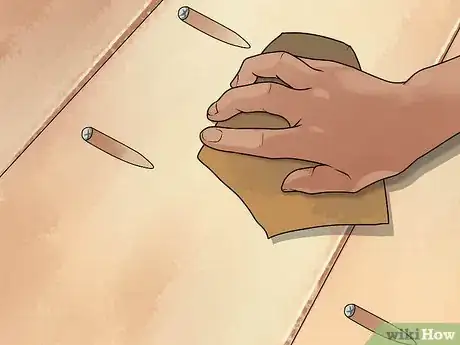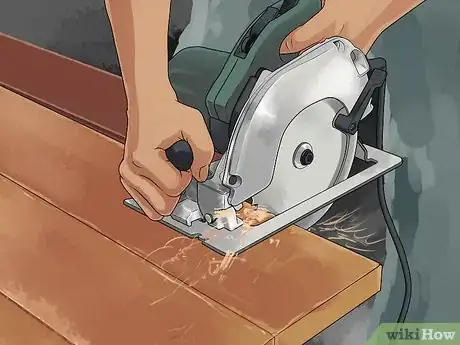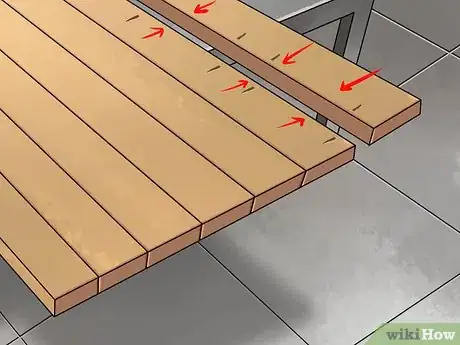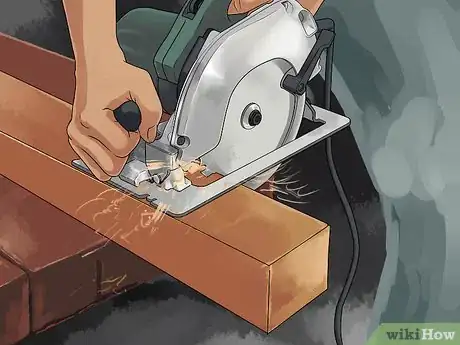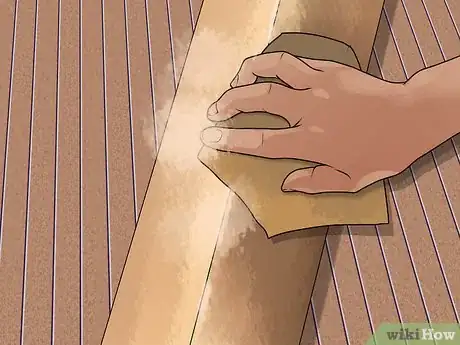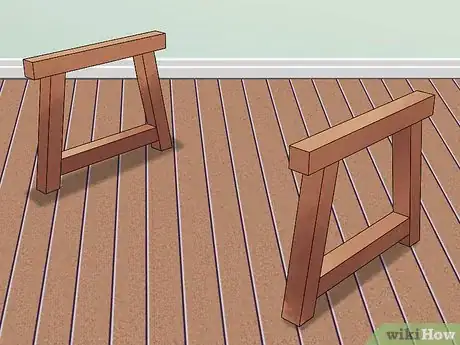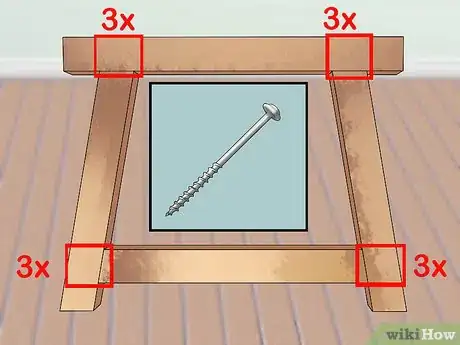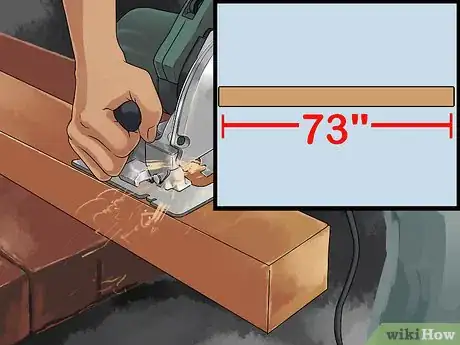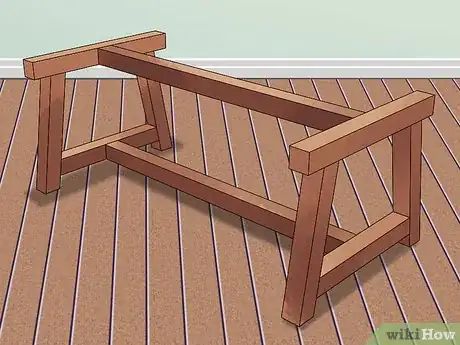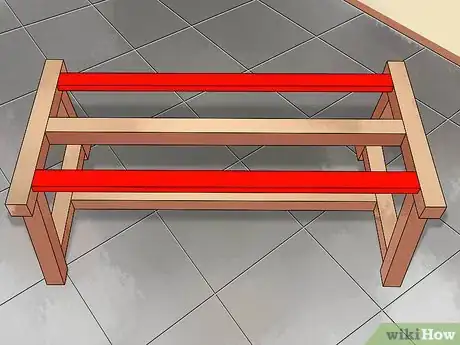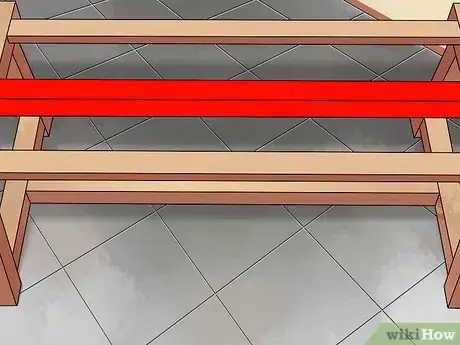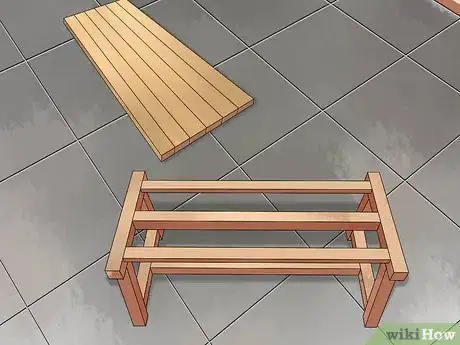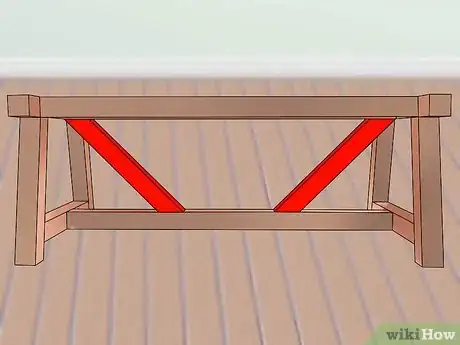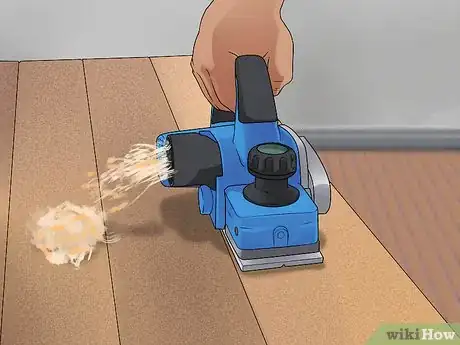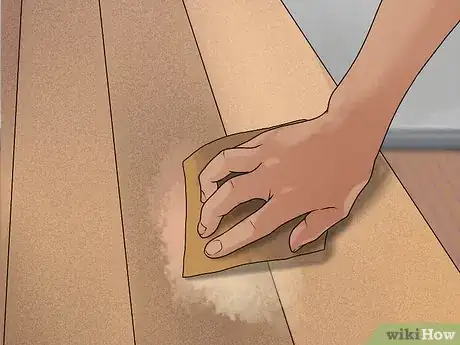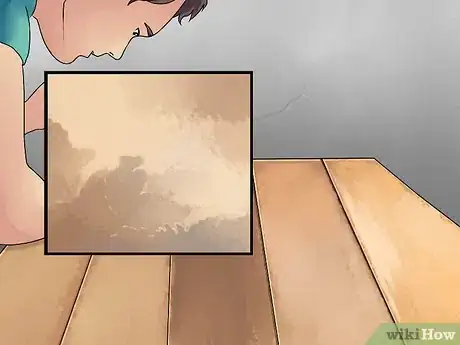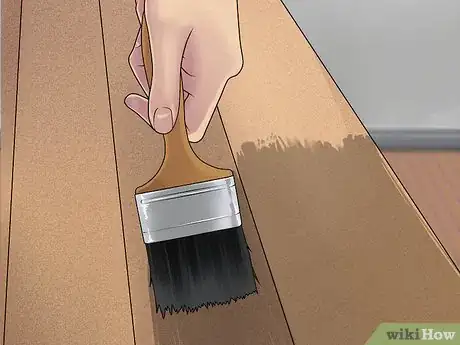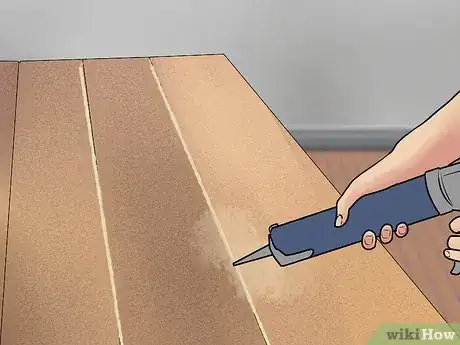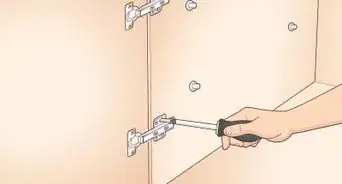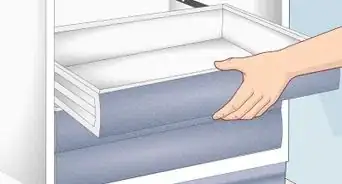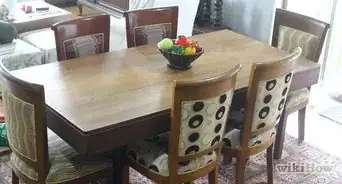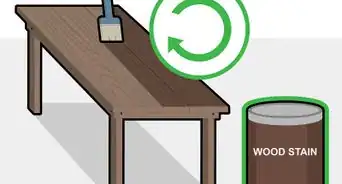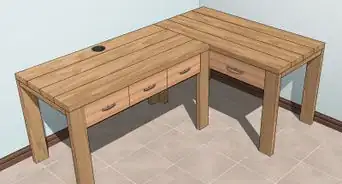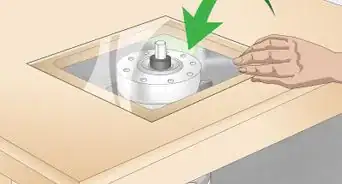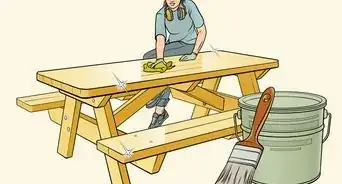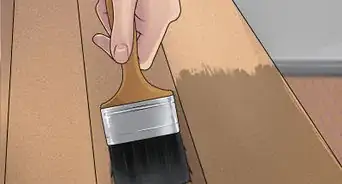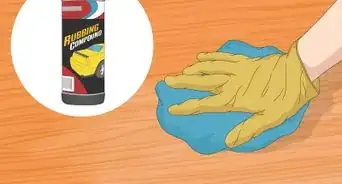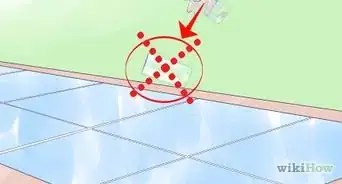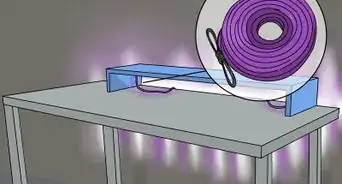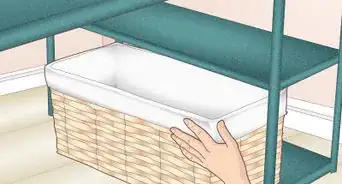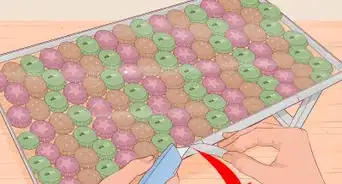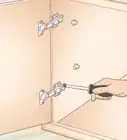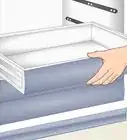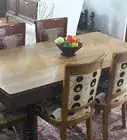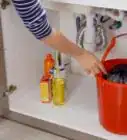This article was co-authored by Jeff Huynh. Jeff Huynh is the owner of Moseybolt, a full service solution in home services, renovations, and repair in the Greater Seattle area. He has over five years of handyman experience. He has a BS in Business Administration from the San Francisco State University and his Certificate in Industrial Electronics Technology from North Seattle College.
This article has been viewed 213,961 times.
Even a beginning woodworker can build a kitchen table if they have a small selection of carpentry tools. These instructions describe a table with surface dimensions about 69" x 46" (175cm x 120cm). You may adjust the plan to a different size by cutting the boards to a different length and by using fewer or narrower boards for the tabletop.
Steps
Building the Tabletop
-
1Cut the lumber for the tabletop. You may use construction-grade lumber if you don't mind a rustic look, but choose boards with as little warp as possible. Measure and mark the cut lines first, then cut the lumber with a miter saw. Cut five 2x10" boards to 69 inches (180 cm) in length.
- If the miter saw is too small to make one cut, cut halfway through, then rotate the board and cut again.
- Refer to the end of this article for a list of all lumber and supplies required. If you'd like to change the measurements of your table, draw a diagram first so you know how much lumber to buy.
EXPERT TIPJeff Huynh is the owner of Moseybolt, a full service solution in home services, renovations, and repair in the Greater Seattle area. He has over five years of handyman experience. He has a BS in Business Administration from the San Francisco State University and his Certificate in Industrial Electronics Technology from North Seattle College.Professional Handyman
 Jeff Huynh
Jeff Huynh
Professional HandymanGather all of the necessary tools and materials. Jeff Huynh, handyman, tells us: "To build a table, you'll need a circular saw, a drill, a screwdriver, a Kreg jig and Kreg screws, torque screws, measuring tape, a random orbital sander, a carpenter square, and either a jigsaw, a miter saw, or a table saw."
-
2Arrange the tabletop on a flat surface. Find the flattest surface you can, such as a garage floor. Lay out the five 69" boards in a row, as flush as possible. A little warp is fine, but try a different order for the boards if there's a major gap.Advertisement
-
3Mark the pocket hole locations. For each border between two boards, draw a series of marks along one side, spacing them 8–10 inches (20.3–25.4 cm) apart. This is where you'll drill pocket holes to hold the tabletop together. In addition, mark two spots on each end of each board, where you'll be attaching breadboard ends.
-
4Adjust the Kreg Jig depth. Insert a drill bit into the depth guide on your Kreg Jig, until the step touches the 1.5 inch (3.8 cm) mark. Tighten the depth collar with an allen wrench.
- The step is the edge between the wide and narrow portions of the drill bit. Don't use the tip of the drill bit as your guide.
-
5Adjust the jig placement. Manually loosen the screw on the back of the jig so you can move the hole guide. Raise or lower it until set to the 1.5 inch (3.8 cm) mark, then tighten the screw.
-
6Drill the pocket holes. Stand the edge of a board into the Kreg Jig, centered on one of your marks. Drill through the hole on top of the Kreg Jig to make a pocket hole in the board. Repeat with each mark on each board.
- It can help to rest the board on a 3/4" spacer, to keep it level.
- Don't forget the marks on the end of each board. Stand the board vertically to drill these.
-
7Lay out the boards. Sweep the floor of sawdust and lay out your boards again, in the same order. Confirm that all ends are flush before you continue.
-
8Attach boards with 2.5 inch (6.3 cm) Kreg screws. Place the screw into one of the pocket holes you just drilled, and drill it in to fasten the boards together. Keep the boards as level and flush as possible while you do this, and check afterward to make sure they haven't shifted. Repeat for each pocket hole between two boards.
- Clamp together the boards if possible. It also helps to weigh down the boards with heavy objects.
-
9Sand the surface. Run your orbital sander over the surface of the boards, as well as both ends of the tabletop.
-
10Cut the breadboard ends. Measure the width of your tabletop to find out how long the breadboard ends should be. Cut two more lengths of 2x10 to this length. This should be about 46¼".[1]
-
11Attach the breadboard ends. Line these up level and flush with the two ends of the table. Drill 2.5" Kreg screws through the remaining pocket holes to attach these two boards. Your tabletop is now complete.
Assembling the Table Base
-
1Cut 4x4 lumber to form the table ends. Cut these with a miter saw, adjusting the saw to cut at an angle where described below. You'll need the following cuts of lumber to form the two ends of the table:[2] [3]
- Two 4x4s to 43" length (end tops)
- Four 4x4s to 25⅜" length, with ends cut parallel at a 10º angle (table legs)
- Two 4x4 at 36¼" length, with ends cut not parallel at 10º angle (end braces)
-
2Sand off rough edges. As before, run an orbital sander over the cut wood to smooth out the surface.
-
3Lay out the end. On a flat surface, lay out a table end as follows:
- Put down one of the 43" "end top."
- Position two 25⅜" legs against the first board, leaning inward in the style of a picnic table.
- Place a 36¼" board between the two legs as a horizontal base. Adjust the position of this piece and the legs until they are flush against each other, and centered under the top board.
-
4Put together the table ends. Drill in three 6" torque screws at each point where two boards touch (twelve screws in all). Put together the second table end the same way you did the first.
- An impact wrench makes it easier to drill in the torque screws and reduces the chance of stripping the bit.
-
5Cut lumber for the long braces. Position the end pieces upside down on either end of the tabletop. Measure the distance between them (it should be about 73"), then cut the following lumber to that dimension:
- Two 4x4s for braces
- Two 2x4s for the apron
- As before, sand the cut surfaces smooth before you continue.
-
6Attach one brace to the end pieces. One of the 4x4 braces connects the top of the table ends. Keep the table ends upside down so you can rest this brace on the floor. Drill each end into the brace with two or three 6" torque screws.
-
7Attach the 2x4 apron with the Kreg Jig. Drill two pocket holes at each end of each 2x4, using the same 1.5" setting as before. Lay these parallel with the 4x4 brace you just drilled, running between the two ends right where the table legs connect to the rest of the table. Drill each pocket hole with 2.5" Kreg screws, as before.
- For greater strength, stand the 2x4s vertically rather than laying them flat.[4]
-
8Attach the final 4x4 brace. You'll have to attach this one in midair, running parallel with the other 4x4, between the two end braces. Either have a friend hold it in place or raise it with two jack clamps. Use two or three 6" torque screws for each end.
-
9Attach the base to the tabletop. Lay the tabletop flat on the floor and place the base on top of it. Drill torque screws through the bottom of the boards and into the tabletop. Place them as follows:
- Two 4.5" torque screws near each end of the end top, outside of the legs
- A 4.5" screw about every 5-6" on the end top, between the legs
- More 4.5" screws every 5-6" along the central lengthwise 4x4 brace.
- Switch to 2.5" torque screws and drill one every 5-6" through the 2x4 apron boards.
-
10Cut and attach diagonal braces. Flip the table on its side. Measure the length of a line running at a 45º angle from the end of the central 4x4 inward to the lower 4x4 brace. (This should be about 26⅛".) Cut two 4x4s to this length, cutting the ends to a 45º angle so they are not parallel with each other. Sand them, then drill them in with three 6" torque screws on each end.
Finishing the Table
-
1Level the top with a hand planer. The tabletop surface may be rough, especially if you used construction-grade lumber. Wear down the worst offending areas with a hand planer.
-
2Sand the table. Start with obvious dents using a 40-60 grit sanding pad. Next, sand the entire table using progressively higher grit, ending with 120 or 220 grit. Be sure to sand the sides of the tabletop as well, especially where the breadboard ends attach to the main surface.
- Optionally, smooth out the corners and top edge of the table with the sander.
-
3Distress the table (optional). If you prefer a well-worn look, you can mark the table with nail dents, saw marks, or any other surface damage you'd like to inflict.
-
4Apply finish. You may refer to our detailed guide, or follow the instructions on the wood finish of your choice. Wipe on the finish with a clean rag. Wait a few hours for the finish to dry, or as directed on the finish instructions.
- You can make your own rustic finish by letting steel wool dissolve in white vinegar. This takes about two or three days in an open Mason jar. Filter the liquid through a paper towel, then wait a few additional hours until it turns an amber color.[5]
-
5Seal the table. A polyurethane sealer will protect from spills and enhance the wood's color. Brush on two or three coats of polyurethane, letting the wood dry for 12+ hours between each coat. For best results, sand the table before each coat and wipe it off with a damp rag.
- Follow the safety instructions on the product. Work in a well-ventilated area or wear a respiratory mask.
- Use a well-made brush in good condition to avoid losing bristles in the polyurethane.
Things You'll Need
-
Enough lumber for:
- Five 2x10s at 69" length
- Two 2x10s at 46¼"
- Two 4x4s at 43"
- Four 4x4s at 25⅜"
- Two 4x4s at 36¼"
- Two 4x4s at 73"
- Two 4x4s at 26⅛"
- Two 2x4s at 73"
- Miter saw
- Kreg Jig
- 2.5" Kreg screws
- 6" torque screws
- 4.5" torque screws
- 2.5" torque screws
- Drill
- Orbital sander
- Impact wrench (recommended)
- Hand planer
- Clean rag
- Finish
- Brush
- Polyurethane sealer
References
- ↑ http://www.diypete.com/how-to-build-a-farmhouse-table/
- ↑ http://www.ana-white.com/2013/09/plans/4x4-truss-beam-table
- ↑ http://www.diypete.com/how-to-build-a-farmhouse-table/
- ↑ http://www.ana-white.com/2013/09/plans/4x4-truss-beam-table
- ↑ http://www.diypete.com/how-to-make-steel-wool-and-vinegar-stain/
About This Article
To build a kitchen table, use a miter saw to cut down 5 pieces of lumber to be 69 inches long, lay the pieces out side by side, and screw them together to form the tabletop. Next, create the table ends by cutting pieces of lumber at an angle and sanding the rough edges down. Then, put together the table ends and use a drill to screw them together. Finally, cut lumber to form the braces and attach them to the table with screws before applying the finish and sealant of your choice. To learn more about the specific dimensions needed for your lumber, read on!
